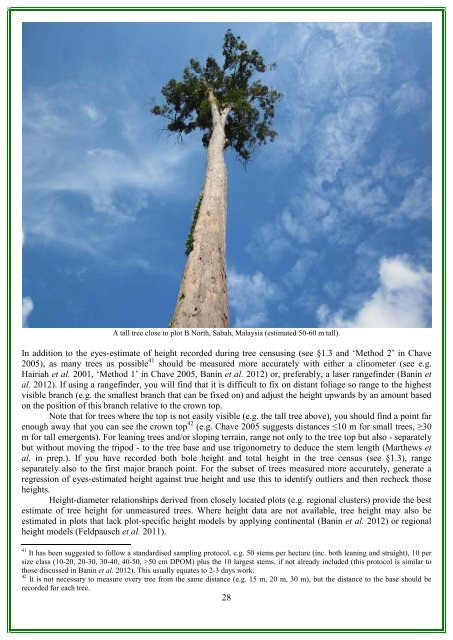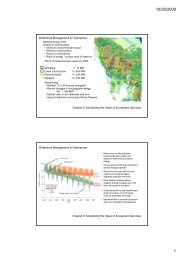RAINFOR GEM Intensive Plots Manual (pdf) - University of Oxford
RAINFOR GEM Intensive Plots Manual (pdf) - University of Oxford
RAINFOR GEM Intensive Plots Manual (pdf) - University of Oxford
- No tags were found...
Create successful ePaper yourself
Turn your PDF publications into a flip-book with our unique Google optimized e-Paper software.
A tall tree close to plot B North, Sabah, Malaysia (estimated 50-60 m tall).In addition to the eyes-estimate <strong>of</strong> height recorded during tree censusing (see §1.3 and ‘Method 2’ in Chave2005), as many trees as possible 41 should be measured more accurately with either a clinometer (see e.g.Hairiah et al. 2001, ‘Method 1’ in Chave 2005, Banin et al. 2012) or, preferably, a laser rangefinder (Banin etal. 2012). If using a rangefinder, you will find that it is difficult to fix on distant foliage so range to the highestvisible branch (e.g. the smallest branch that can be fixed on) and adjust the height upwards by an amount basedon the position <strong>of</strong> this branch relative to the crown top.Note that for trees where the top is not easily visible (e.g. the tall tree above), you should find a point farenough away that you can see the crown top 42 (e.g. Chave 2005 suggests distances ≤10 m for small trees, ≥30m for tall emergents). For leaning trees and/or sloping terrain, range not only to the tree top but also - separatelybut without moving the tripod - to the tree base and use trigonometry to deduce the stem length (Marthews etal. in prep.). If you have recorded both bole height and total height in the tree census (see §1.3), rangeseparately also to the first major branch point. For the subset <strong>of</strong> trees measured more accurately, generate aregression <strong>of</strong> eyes-estimated height against true height and use this to identify outliers and then recheck thoseheights.Height-diameter relationships derived from closely located plots (e.g. regional clusters) provide the bestestimate <strong>of</strong> tree height for unmeasured trees. Where height data are not available, tree height may also beestimated in plots that lack plot-specific height models by applying continental (Banin et al. 2012) or regionalheight models (Feldpausch et al. 2011).41 It has been suggested to follow a standardised sampling protocol, e.g. 50 stems per hectare (inc. both leaning and straight), 10 persize class (10-20, 20-30, 30-40, 40-50, >50 cm DPOM) plus the 10 largest stems, if not already included (this protocol is similar tothose discussed in Banin et al. 2012). This usually equates to 2-3 days work.42 It is not necessary to measure every tree from the same distance (e.g. 15 m, 20 m, 30 m), but the distance to the base should berecorded for each tree.28





